Brand Management: Importance, Strategy, and Equity
VerifiedAdded on 2023/01/09
|15
|4333
|66
AI Summary
This document provides an overview of brand management, including the importance of branding in marketing, successful strategies for building and managing brand equity, portfolio management, brand hierarchies, and techniques for measuring and managing brand value. It also includes examples and theories for successful brand management.
Contribute Materials
Your contribution can guide someone’s learning journey. Share your
documents today.

BRAND MANAGEMENT
Secure Best Marks with AI Grader
Need help grading? Try our AI Grader for instant feedback on your assignments.
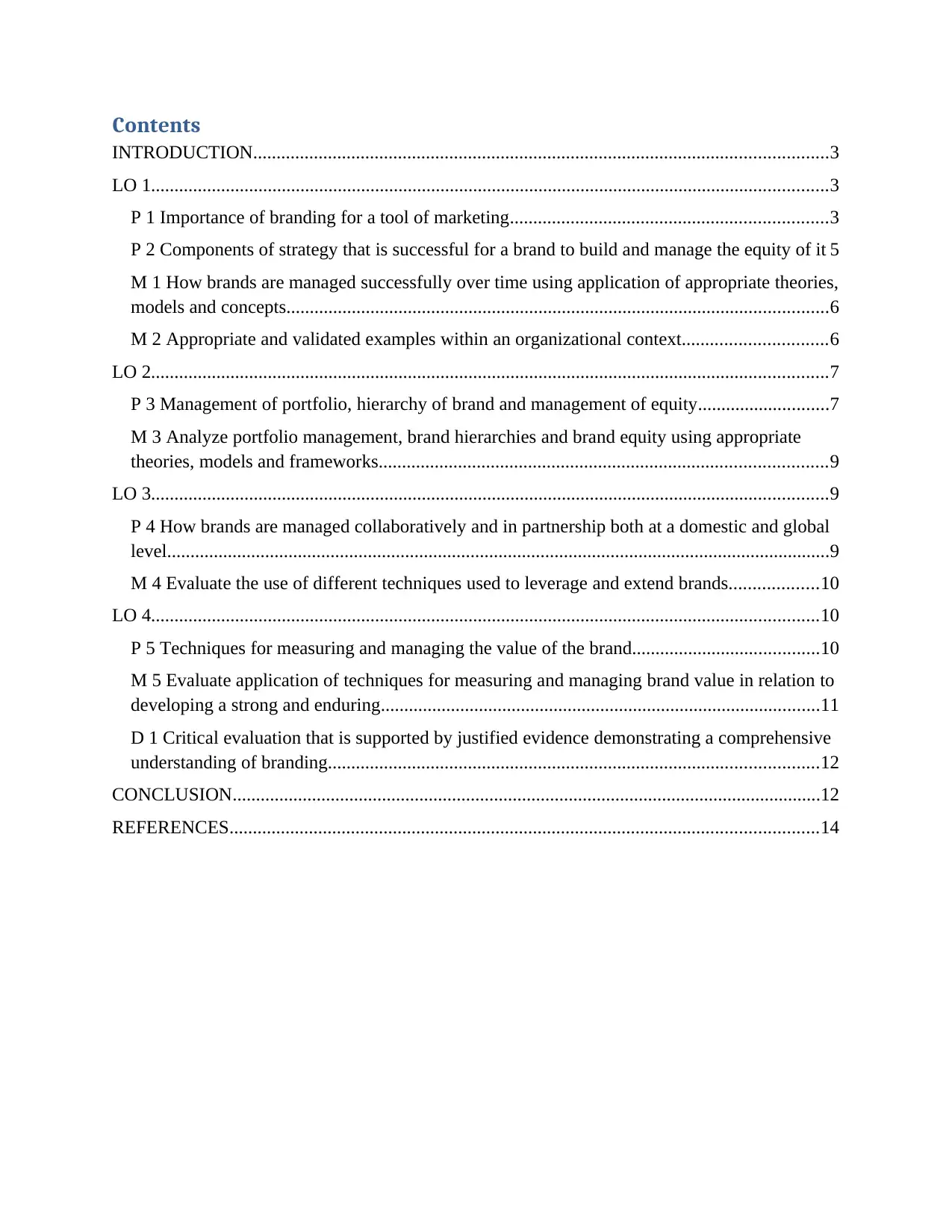
Contents
INTRODUCTION...........................................................................................................................3
LO 1.................................................................................................................................................3
P 1 Importance of branding for a tool of marketing....................................................................3
P 2 Components of strategy that is successful for a brand to build and manage the equity of it 5
M 1 How brands are managed successfully over time using application of appropriate theories,
models and concepts....................................................................................................................6
M 2 Appropriate and validated examples within an organizational context...............................6
LO 2.................................................................................................................................................7
P 3 Management of portfolio, hierarchy of brand and management of equity............................7
M 3 Analyze portfolio management, brand hierarchies and brand equity using appropriate
theories, models and frameworks................................................................................................9
LO 3.................................................................................................................................................9
P 4 How brands are managed collaboratively and in partnership both at a domestic and global
level..............................................................................................................................................9
M 4 Evaluate the use of different techniques used to leverage and extend brands...................10
LO 4...............................................................................................................................................10
P 5 Techniques for measuring and managing the value of the brand........................................10
M 5 Evaluate application of techniques for measuring and managing brand value in relation to
developing a strong and enduring..............................................................................................11
D 1 Critical evaluation that is supported by justified evidence demonstrating a comprehensive
understanding of branding.........................................................................................................12
CONCLUSION..............................................................................................................................12
REFERENCES..............................................................................................................................14
INTRODUCTION...........................................................................................................................3
LO 1.................................................................................................................................................3
P 1 Importance of branding for a tool of marketing....................................................................3
P 2 Components of strategy that is successful for a brand to build and manage the equity of it 5
M 1 How brands are managed successfully over time using application of appropriate theories,
models and concepts....................................................................................................................6
M 2 Appropriate and validated examples within an organizational context...............................6
LO 2.................................................................................................................................................7
P 3 Management of portfolio, hierarchy of brand and management of equity............................7
M 3 Analyze portfolio management, brand hierarchies and brand equity using appropriate
theories, models and frameworks................................................................................................9
LO 3.................................................................................................................................................9
P 4 How brands are managed collaboratively and in partnership both at a domestic and global
level..............................................................................................................................................9
M 4 Evaluate the use of different techniques used to leverage and extend brands...................10
LO 4...............................................................................................................................................10
P 5 Techniques for measuring and managing the value of the brand........................................10
M 5 Evaluate application of techniques for measuring and managing brand value in relation to
developing a strong and enduring..............................................................................................11
D 1 Critical evaluation that is supported by justified evidence demonstrating a comprehensive
understanding of branding.........................................................................................................12
CONCLUSION..............................................................................................................................12
REFERENCES..............................................................................................................................14
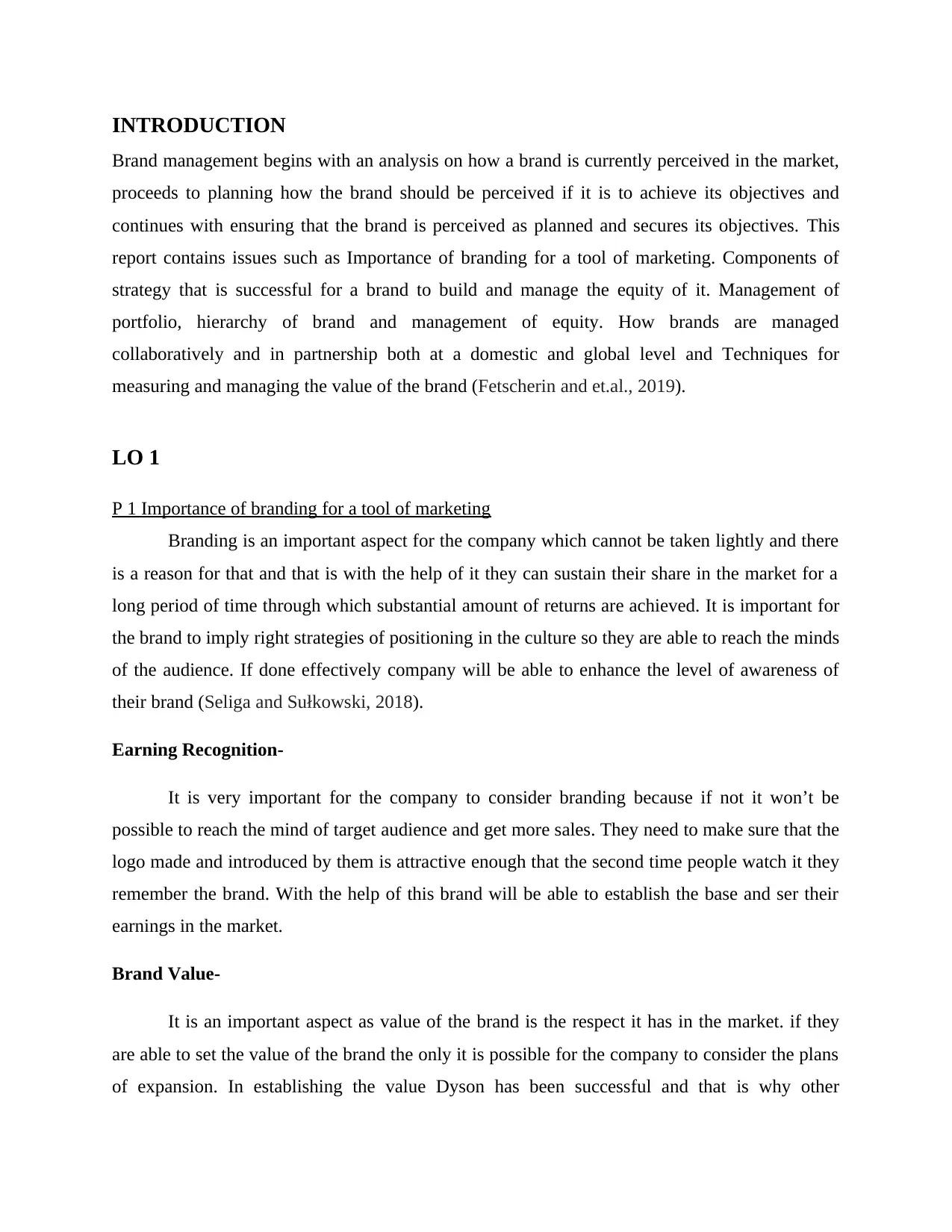
INTRODUCTION
Brand management begins with an analysis on how a brand is currently perceived in the market,
proceeds to planning how the brand should be perceived if it is to achieve its objectives and
continues with ensuring that the brand is perceived as planned and secures its objectives. This
report contains issues such as Importance of branding for a tool of marketing. Components of
strategy that is successful for a brand to build and manage the equity of it. Management of
portfolio, hierarchy of brand and management of equity. How brands are managed
collaboratively and in partnership both at a domestic and global level and Techniques for
measuring and managing the value of the brand (Fetscherin and et.al., 2019).
LO 1
P 1 Importance of branding for a tool of marketing
Branding is an important aspect for the company which cannot be taken lightly and there
is a reason for that and that is with the help of it they can sustain their share in the market for a
long period of time through which substantial amount of returns are achieved. It is important for
the brand to imply right strategies of positioning in the culture so they are able to reach the minds
of the audience. If done effectively company will be able to enhance the level of awareness of
their brand (Seliga and Sułkowski, 2018).
Earning Recognition-
It is very important for the company to consider branding because if not it won’t be
possible to reach the mind of target audience and get more sales. They need to make sure that the
logo made and introduced by them is attractive enough that the second time people watch it they
remember the brand. With the help of this brand will be able to establish the base and ser their
earnings in the market.
Brand Value-
It is an important aspect as value of the brand is the respect it has in the market. if they
are able to set the value of the brand the only it is possible for the company to consider the plans
of expansion. In establishing the value Dyson has been successful and that is why other
Brand management begins with an analysis on how a brand is currently perceived in the market,
proceeds to planning how the brand should be perceived if it is to achieve its objectives and
continues with ensuring that the brand is perceived as planned and secures its objectives. This
report contains issues such as Importance of branding for a tool of marketing. Components of
strategy that is successful for a brand to build and manage the equity of it. Management of
portfolio, hierarchy of brand and management of equity. How brands are managed
collaboratively and in partnership both at a domestic and global level and Techniques for
measuring and managing the value of the brand (Fetscherin and et.al., 2019).
LO 1
P 1 Importance of branding for a tool of marketing
Branding is an important aspect for the company which cannot be taken lightly and there
is a reason for that and that is with the help of it they can sustain their share in the market for a
long period of time through which substantial amount of returns are achieved. It is important for
the brand to imply right strategies of positioning in the culture so they are able to reach the minds
of the audience. If done effectively company will be able to enhance the level of awareness of
their brand (Seliga and Sułkowski, 2018).
Earning Recognition-
It is very important for the company to consider branding because if not it won’t be
possible to reach the mind of target audience and get more sales. They need to make sure that the
logo made and introduced by them is attractive enough that the second time people watch it they
remember the brand. With the help of this brand will be able to establish the base and ser their
earnings in the market.
Brand Value-
It is an important aspect as value of the brand is the respect it has in the market. if they
are able to set the value of the brand the only it is possible for the company to consider the plans
of expansion. In establishing the value Dyson has been successful and that is why other
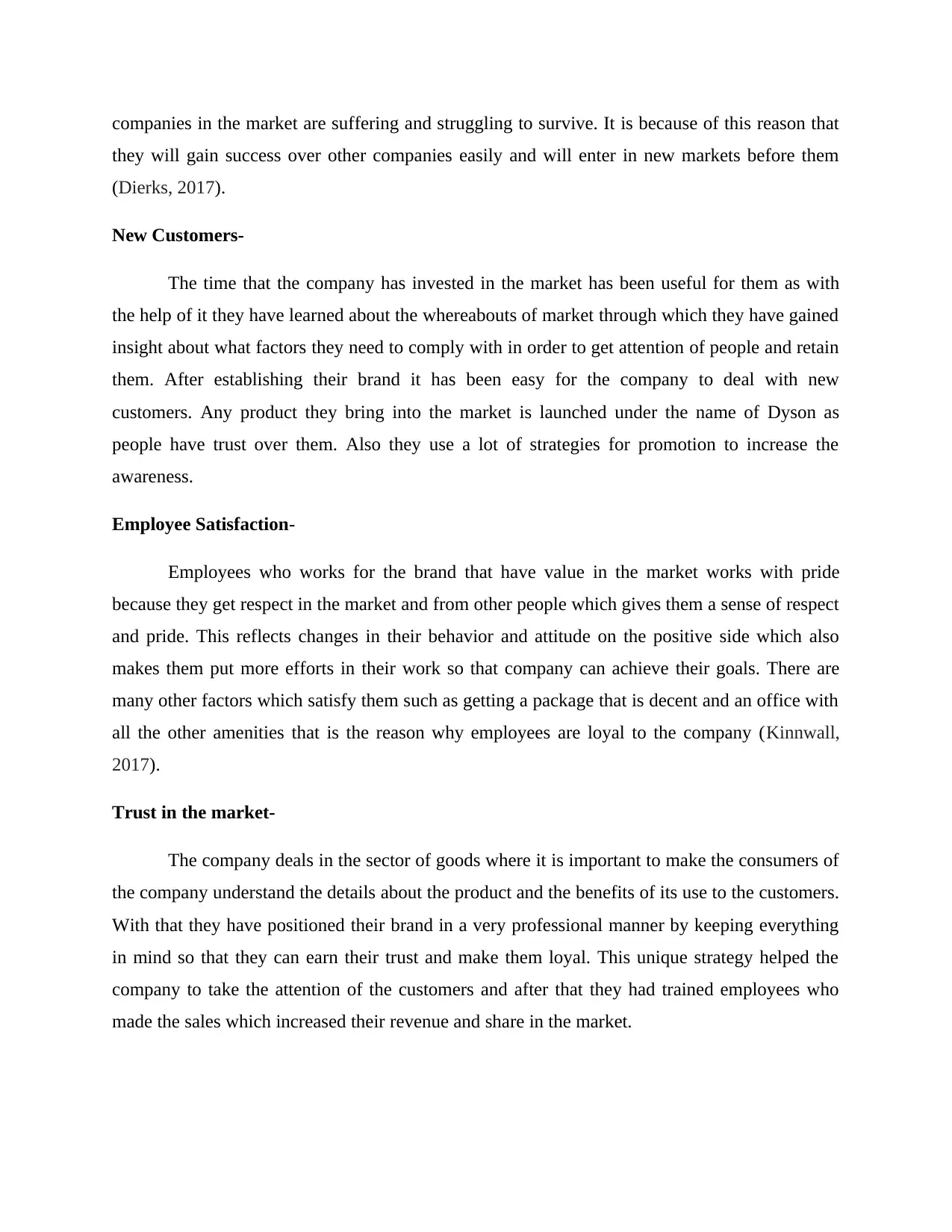
companies in the market are suffering and struggling to survive. It is because of this reason that
they will gain success over other companies easily and will enter in new markets before them
(Dierks, 2017).
New Customers-
The time that the company has invested in the market has been useful for them as with
the help of it they have learned about the whereabouts of market through which they have gained
insight about what factors they need to comply with in order to get attention of people and retain
them. After establishing their brand it has been easy for the company to deal with new
customers. Any product they bring into the market is launched under the name of Dyson as
people have trust over them. Also they use a lot of strategies for promotion to increase the
awareness.
Employee Satisfaction-
Employees who works for the brand that have value in the market works with pride
because they get respect in the market and from other people which gives them a sense of respect
and pride. This reflects changes in their behavior and attitude on the positive side which also
makes them put more efforts in their work so that company can achieve their goals. There are
many other factors which satisfy them such as getting a package that is decent and an office with
all the other amenities that is the reason why employees are loyal to the company (Kinnwall,
2017).
Trust in the market-
The company deals in the sector of goods where it is important to make the consumers of
the company understand the details about the product and the benefits of its use to the customers.
With that they have positioned their brand in a very professional manner by keeping everything
in mind so that they can earn their trust and make them loyal. This unique strategy helped the
company to take the attention of the customers and after that they had trained employees who
made the sales which increased their revenue and share in the market.
they will gain success over other companies easily and will enter in new markets before them
(Dierks, 2017).
New Customers-
The time that the company has invested in the market has been useful for them as with
the help of it they have learned about the whereabouts of market through which they have gained
insight about what factors they need to comply with in order to get attention of people and retain
them. After establishing their brand it has been easy for the company to deal with new
customers. Any product they bring into the market is launched under the name of Dyson as
people have trust over them. Also they use a lot of strategies for promotion to increase the
awareness.
Employee Satisfaction-
Employees who works for the brand that have value in the market works with pride
because they get respect in the market and from other people which gives them a sense of respect
and pride. This reflects changes in their behavior and attitude on the positive side which also
makes them put more efforts in their work so that company can achieve their goals. There are
many other factors which satisfy them such as getting a package that is decent and an office with
all the other amenities that is the reason why employees are loyal to the company (Kinnwall,
2017).
Trust in the market-
The company deals in the sector of goods where it is important to make the consumers of
the company understand the details about the product and the benefits of its use to the customers.
With that they have positioned their brand in a very professional manner by keeping everything
in mind so that they can earn their trust and make them loyal. This unique strategy helped the
company to take the attention of the customers and after that they had trained employees who
made the sales which increased their revenue and share in the market.
Secure Best Marks with AI Grader
Need help grading? Try our AI Grader for instant feedback on your assignments.
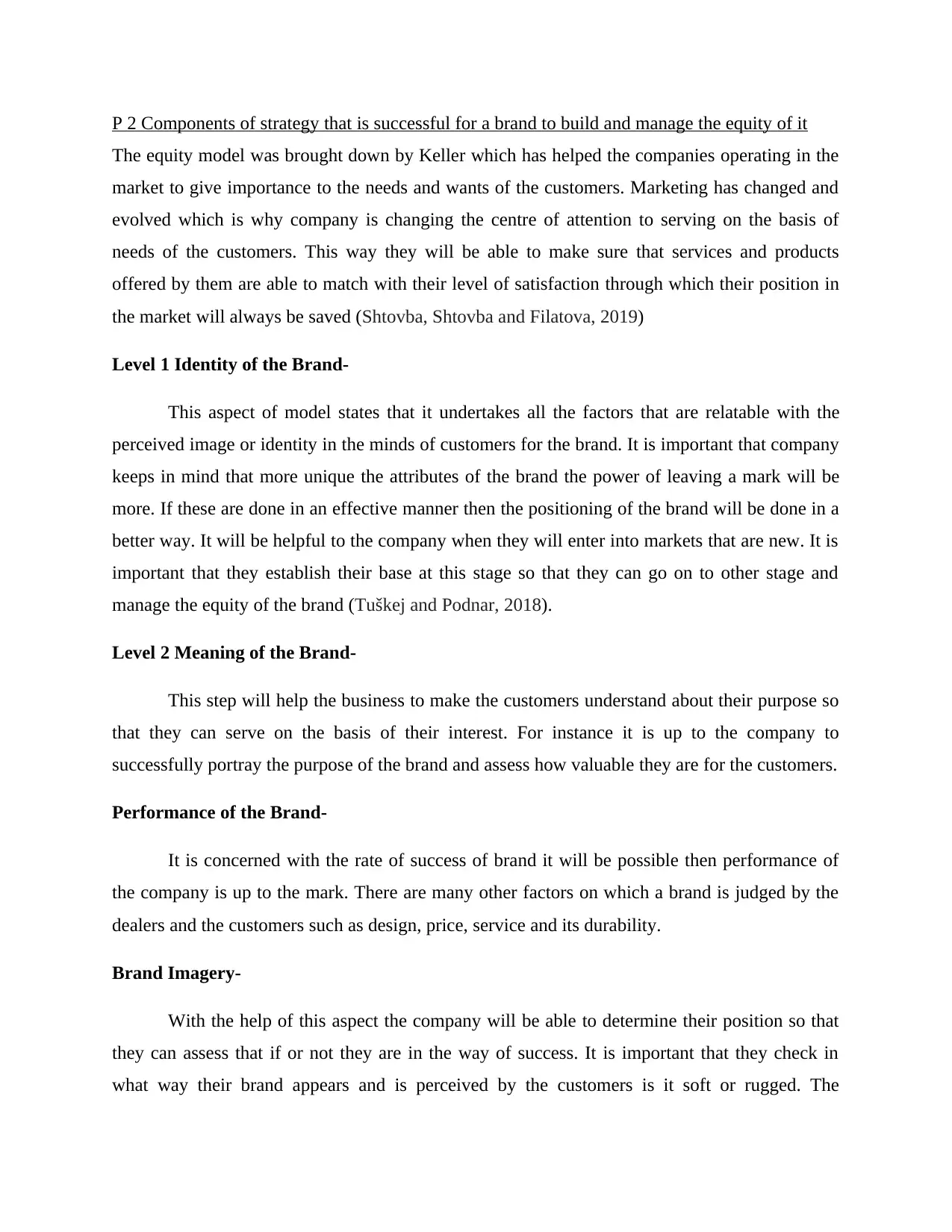
P 2 Components of strategy that is successful for a brand to build and manage the equity of it
The equity model was brought down by Keller which has helped the companies operating in the
market to give importance to the needs and wants of the customers. Marketing has changed and
evolved which is why company is changing the centre of attention to serving on the basis of
needs of the customers. This way they will be able to make sure that services and products
offered by them are able to match with their level of satisfaction through which their position in
the market will always be saved (Shtovba, Shtovba and Filatova, 2019)
Level 1 Identity of the Brand-
This aspect of model states that it undertakes all the factors that are relatable with the
perceived image or identity in the minds of customers for the brand. It is important that company
keeps in mind that more unique the attributes of the brand the power of leaving a mark will be
more. If these are done in an effective manner then the positioning of the brand will be done in a
better way. It will be helpful to the company when they will enter into markets that are new. It is
important that they establish their base at this stage so that they can go on to other stage and
manage the equity of the brand (Tuškej and Podnar, 2018).
Level 2 Meaning of the Brand-
This step will help the business to make the customers understand about their purpose so
that they can serve on the basis of their interest. For instance it is up to the company to
successfully portray the purpose of the brand and assess how valuable they are for the customers.
Performance of the Brand-
It is concerned with the rate of success of brand it will be possible then performance of
the company is up to the mark. There are many other factors on which a brand is judged by the
dealers and the customers such as design, price, service and its durability.
Brand Imagery-
With the help of this aspect the company will be able to determine their position so that
they can assess that if or not they are in the way of success. It is important that they check in
what way their brand appears and is perceived by the customers is it soft or rugged. The
The equity model was brought down by Keller which has helped the companies operating in the
market to give importance to the needs and wants of the customers. Marketing has changed and
evolved which is why company is changing the centre of attention to serving on the basis of
needs of the customers. This way they will be able to make sure that services and products
offered by them are able to match with their level of satisfaction through which their position in
the market will always be saved (Shtovba, Shtovba and Filatova, 2019)
Level 1 Identity of the Brand-
This aspect of model states that it undertakes all the factors that are relatable with the
perceived image or identity in the minds of customers for the brand. It is important that company
keeps in mind that more unique the attributes of the brand the power of leaving a mark will be
more. If these are done in an effective manner then the positioning of the brand will be done in a
better way. It will be helpful to the company when they will enter into markets that are new. It is
important that they establish their base at this stage so that they can go on to other stage and
manage the equity of the brand (Tuškej and Podnar, 2018).
Level 2 Meaning of the Brand-
This step will help the business to make the customers understand about their purpose so
that they can serve on the basis of their interest. For instance it is up to the company to
successfully portray the purpose of the brand and assess how valuable they are for the customers.
Performance of the Brand-
It is concerned with the rate of success of brand it will be possible then performance of
the company is up to the mark. There are many other factors on which a brand is judged by the
dealers and the customers such as design, price, service and its durability.
Brand Imagery-
With the help of this aspect the company will be able to determine their position so that
they can assess that if or not they are in the way of success. It is important that they check in
what way their brand appears and is perceived by the customers is it soft or rugged. The
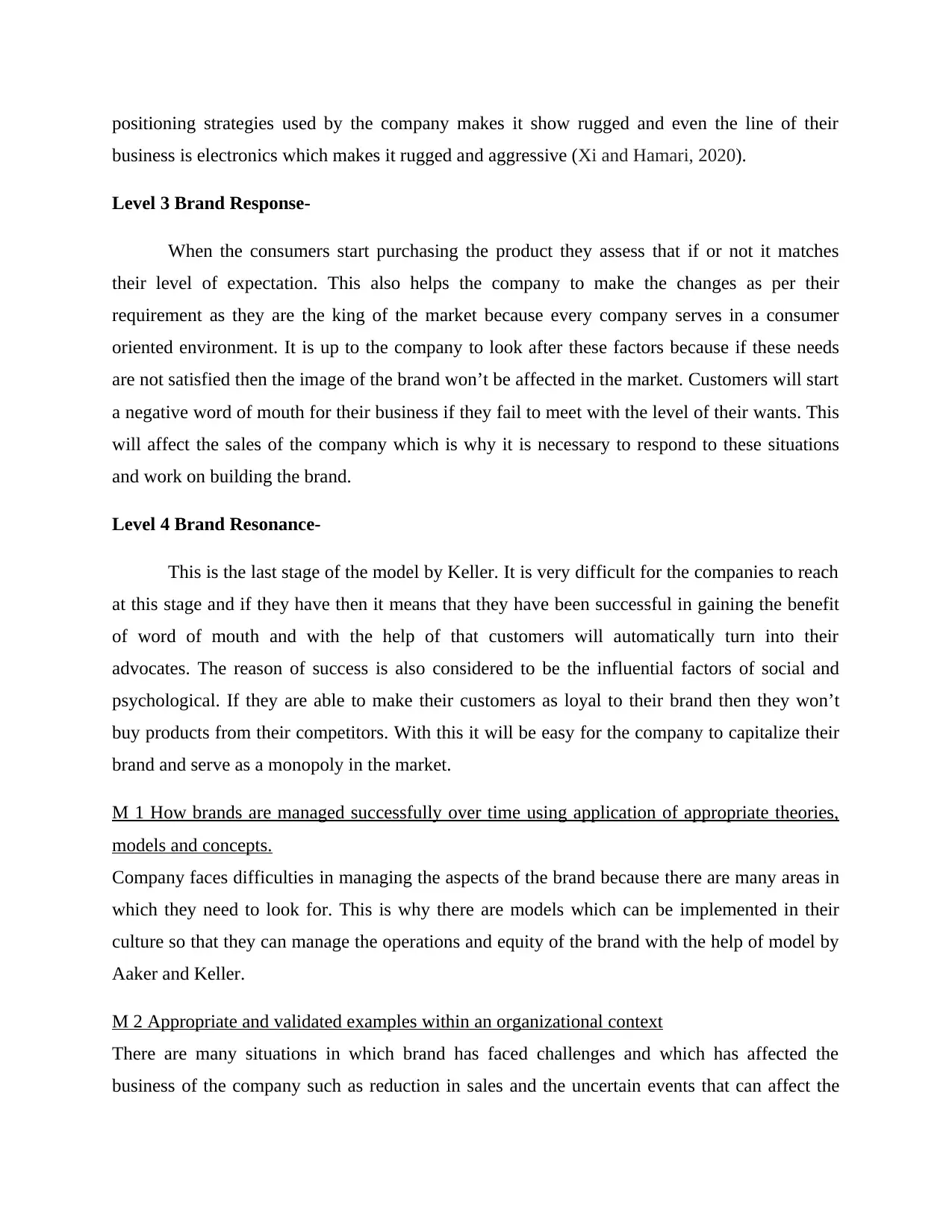
positioning strategies used by the company makes it show rugged and even the line of their
business is electronics which makes it rugged and aggressive (Xi and Hamari, 2020).
Level 3 Brand Response-
When the consumers start purchasing the product they assess that if or not it matches
their level of expectation. This also helps the company to make the changes as per their
requirement as they are the king of the market because every company serves in a consumer
oriented environment. It is up to the company to look after these factors because if these needs
are not satisfied then the image of the brand won’t be affected in the market. Customers will start
a negative word of mouth for their business if they fail to meet with the level of their wants. This
will affect the sales of the company which is why it is necessary to respond to these situations
and work on building the brand.
Level 4 Brand Resonance-
This is the last stage of the model by Keller. It is very difficult for the companies to reach
at this stage and if they have then it means that they have been successful in gaining the benefit
of word of mouth and with the help of that customers will automatically turn into their
advocates. The reason of success is also considered to be the influential factors of social and
psychological. If they are able to make their customers as loyal to their brand then they won’t
buy products from their competitors. With this it will be easy for the company to capitalize their
brand and serve as a monopoly in the market.
M 1 How brands are managed successfully over time using application of appropriate theories,
models and concepts.
Company faces difficulties in managing the aspects of the brand because there are many areas in
which they need to look for. This is why there are models which can be implemented in their
culture so that they can manage the operations and equity of the brand with the help of model by
Aaker and Keller.
M 2 Appropriate and validated examples within an organizational context
There are many situations in which brand has faced challenges and which has affected the
business of the company such as reduction in sales and the uncertain events that can affect the
business is electronics which makes it rugged and aggressive (Xi and Hamari, 2020).
Level 3 Brand Response-
When the consumers start purchasing the product they assess that if or not it matches
their level of expectation. This also helps the company to make the changes as per their
requirement as they are the king of the market because every company serves in a consumer
oriented environment. It is up to the company to look after these factors because if these needs
are not satisfied then the image of the brand won’t be affected in the market. Customers will start
a negative word of mouth for their business if they fail to meet with the level of their wants. This
will affect the sales of the company which is why it is necessary to respond to these situations
and work on building the brand.
Level 4 Brand Resonance-
This is the last stage of the model by Keller. It is very difficult for the companies to reach
at this stage and if they have then it means that they have been successful in gaining the benefit
of word of mouth and with the help of that customers will automatically turn into their
advocates. The reason of success is also considered to be the influential factors of social and
psychological. If they are able to make their customers as loyal to their brand then they won’t
buy products from their competitors. With this it will be easy for the company to capitalize their
brand and serve as a monopoly in the market.
M 1 How brands are managed successfully over time using application of appropriate theories,
models and concepts.
Company faces difficulties in managing the aspects of the brand because there are many areas in
which they need to look for. This is why there are models which can be implemented in their
culture so that they can manage the operations and equity of the brand with the help of model by
Aaker and Keller.
M 2 Appropriate and validated examples within an organizational context
There are many situations in which brand has faced challenges and which has affected the
business of the company such as reduction in sales and the uncertain events that can affect the
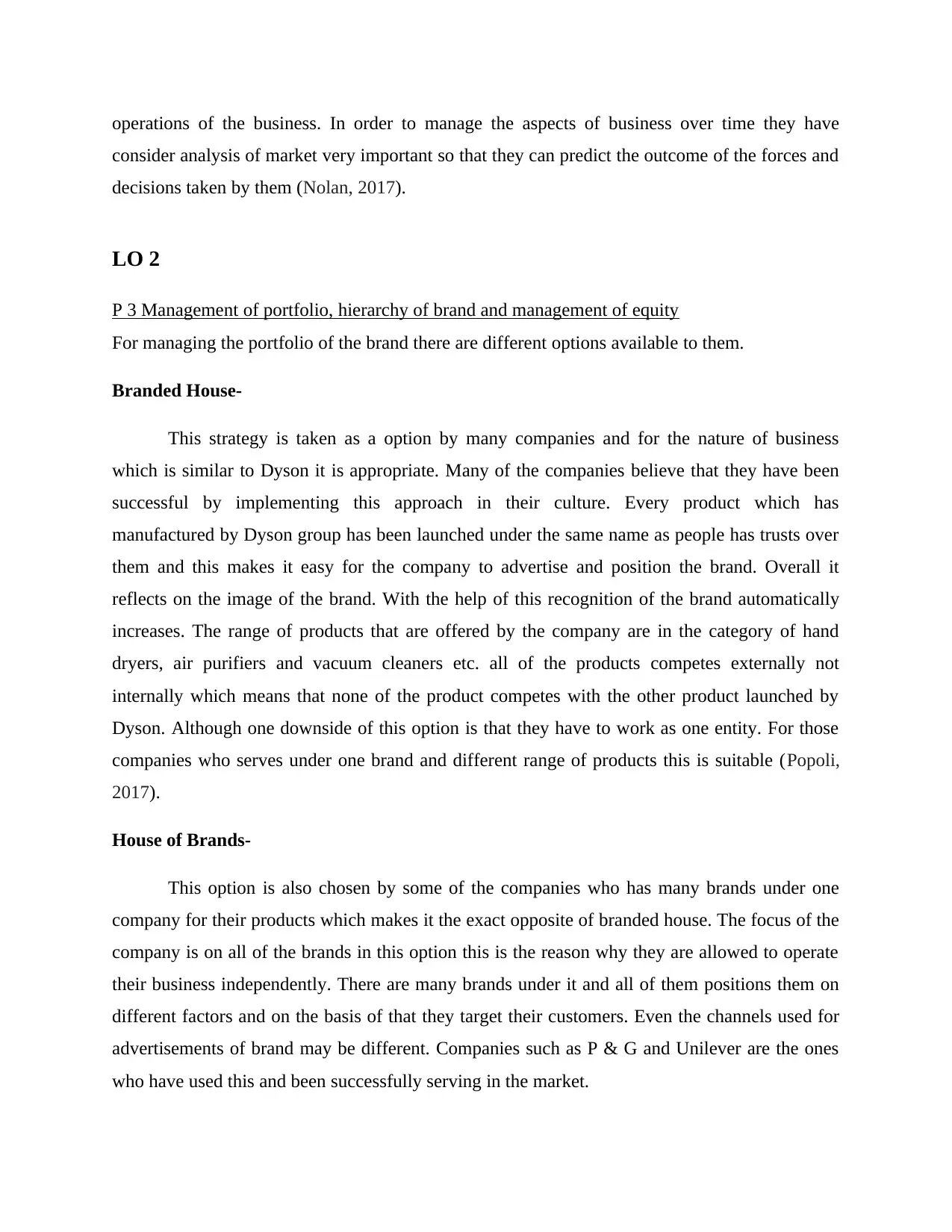
operations of the business. In order to manage the aspects of business over time they have
consider analysis of market very important so that they can predict the outcome of the forces and
decisions taken by them (Nolan, 2017).
LO 2
P 3 Management of portfolio, hierarchy of brand and management of equity
For managing the portfolio of the brand there are different options available to them.
Branded House-
This strategy is taken as a option by many companies and for the nature of business
which is similar to Dyson it is appropriate. Many of the companies believe that they have been
successful by implementing this approach in their culture. Every product which has
manufactured by Dyson group has been launched under the same name as people has trusts over
them and this makes it easy for the company to advertise and position the brand. Overall it
reflects on the image of the brand. With the help of this recognition of the brand automatically
increases. The range of products that are offered by the company are in the category of hand
dryers, air purifiers and vacuum cleaners etc. all of the products competes externally not
internally which means that none of the product competes with the other product launched by
Dyson. Although one downside of this option is that they have to work as one entity. For those
companies who serves under one brand and different range of products this is suitable (Popoli,
2017).
House of Brands-
This option is also chosen by some of the companies who has many brands under one
company for their products which makes it the exact opposite of branded house. The focus of the
company is on all of the brands in this option this is the reason why they are allowed to operate
their business independently. There are many brands under it and all of them positions them on
different factors and on the basis of that they target their customers. Even the channels used for
advertisements of brand may be different. Companies such as P & G and Unilever are the ones
who have used this and been successfully serving in the market.
consider analysis of market very important so that they can predict the outcome of the forces and
decisions taken by them (Nolan, 2017).
LO 2
P 3 Management of portfolio, hierarchy of brand and management of equity
For managing the portfolio of the brand there are different options available to them.
Branded House-
This strategy is taken as a option by many companies and for the nature of business
which is similar to Dyson it is appropriate. Many of the companies believe that they have been
successful by implementing this approach in their culture. Every product which has
manufactured by Dyson group has been launched under the same name as people has trusts over
them and this makes it easy for the company to advertise and position the brand. Overall it
reflects on the image of the brand. With the help of this recognition of the brand automatically
increases. The range of products that are offered by the company are in the category of hand
dryers, air purifiers and vacuum cleaners etc. all of the products competes externally not
internally which means that none of the product competes with the other product launched by
Dyson. Although one downside of this option is that they have to work as one entity. For those
companies who serves under one brand and different range of products this is suitable (Popoli,
2017).
House of Brands-
This option is also chosen by some of the companies who has many brands under one
company for their products which makes it the exact opposite of branded house. The focus of the
company is on all of the brands in this option this is the reason why they are allowed to operate
their business independently. There are many brands under it and all of them positions them on
different factors and on the basis of that they target their customers. Even the channels used for
advertisements of brand may be different. Companies such as P & G and Unilever are the ones
who have used this and been successfully serving in the market.
Paraphrase This Document
Need a fresh take? Get an instant paraphrase of this document with our AI Paraphraser
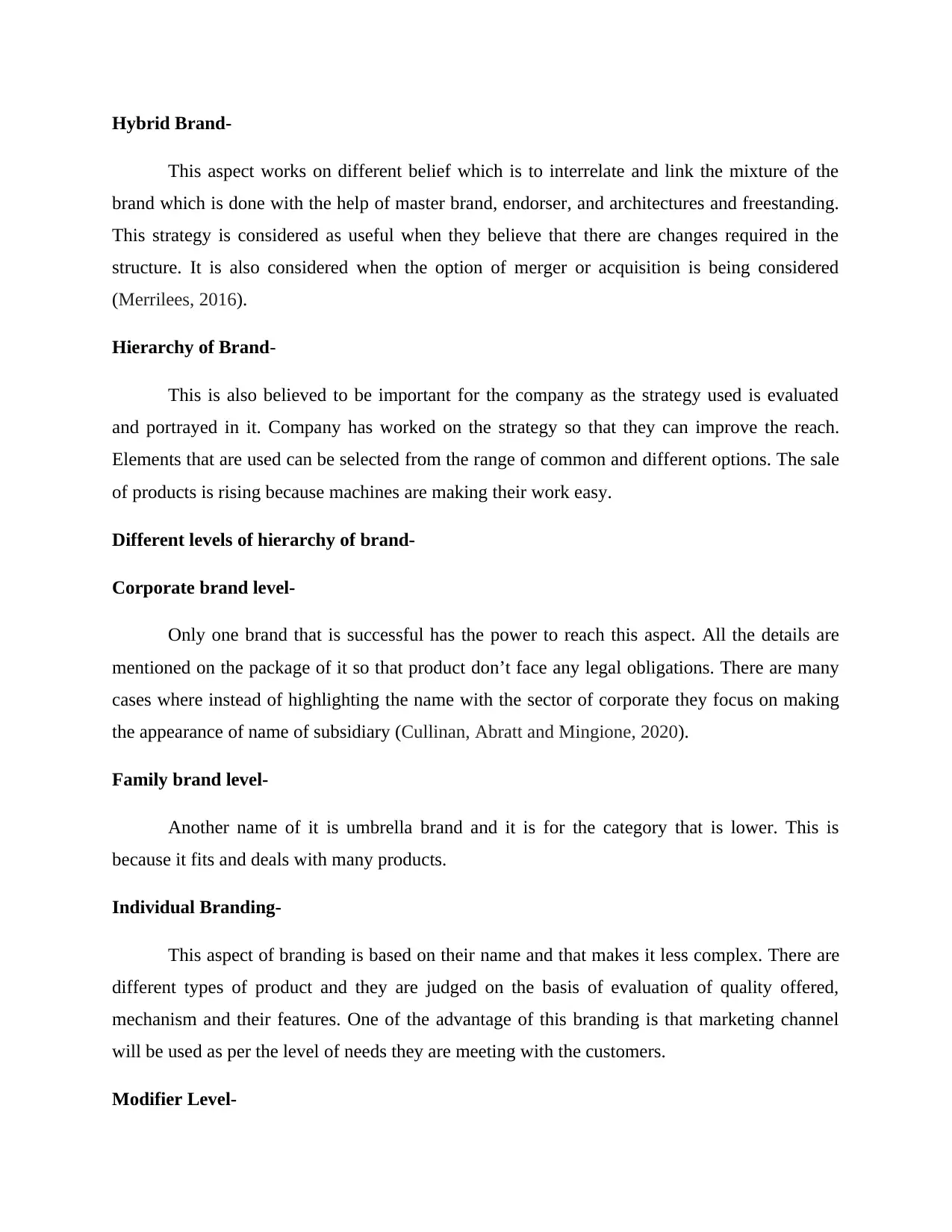
Hybrid Brand-
This aspect works on different belief which is to interrelate and link the mixture of the
brand which is done with the help of master brand, endorser, and architectures and freestanding.
This strategy is considered as useful when they believe that there are changes required in the
structure. It is also considered when the option of merger or acquisition is being considered
(Merrilees, 2016).
Hierarchy of Brand-
This is also believed to be important for the company as the strategy used is evaluated
and portrayed in it. Company has worked on the strategy so that they can improve the reach.
Elements that are used can be selected from the range of common and different options. The sale
of products is rising because machines are making their work easy.
Different levels of hierarchy of brand-
Corporate brand level-
Only one brand that is successful has the power to reach this aspect. All the details are
mentioned on the package of it so that product don’t face any legal obligations. There are many
cases where instead of highlighting the name with the sector of corporate they focus on making
the appearance of name of subsidiary (Cullinan, Abratt and Mingione, 2020).
Family brand level-
Another name of it is umbrella brand and it is for the category that is lower. This is
because it fits and deals with many products.
Individual Branding-
This aspect of branding is based on their name and that makes it less complex. There are
different types of product and they are judged on the basis of evaluation of quality offered,
mechanism and their features. One of the advantage of this branding is that marketing channel
will be used as per the level of needs they are meeting with the customers.
Modifier Level-
This aspect works on different belief which is to interrelate and link the mixture of the
brand which is done with the help of master brand, endorser, and architectures and freestanding.
This strategy is considered as useful when they believe that there are changes required in the
structure. It is also considered when the option of merger or acquisition is being considered
(Merrilees, 2016).
Hierarchy of Brand-
This is also believed to be important for the company as the strategy used is evaluated
and portrayed in it. Company has worked on the strategy so that they can improve the reach.
Elements that are used can be selected from the range of common and different options. The sale
of products is rising because machines are making their work easy.
Different levels of hierarchy of brand-
Corporate brand level-
Only one brand that is successful has the power to reach this aspect. All the details are
mentioned on the package of it so that product don’t face any legal obligations. There are many
cases where instead of highlighting the name with the sector of corporate they focus on making
the appearance of name of subsidiary (Cullinan, Abratt and Mingione, 2020).
Family brand level-
Another name of it is umbrella brand and it is for the category that is lower. This is
because it fits and deals with many products.
Individual Branding-
This aspect of branding is based on their name and that makes it less complex. There are
different types of product and they are judged on the basis of evaluation of quality offered,
mechanism and their features. One of the advantage of this branding is that marketing channel
will be used as per the level of needs they are meeting with the customers.
Modifier Level-
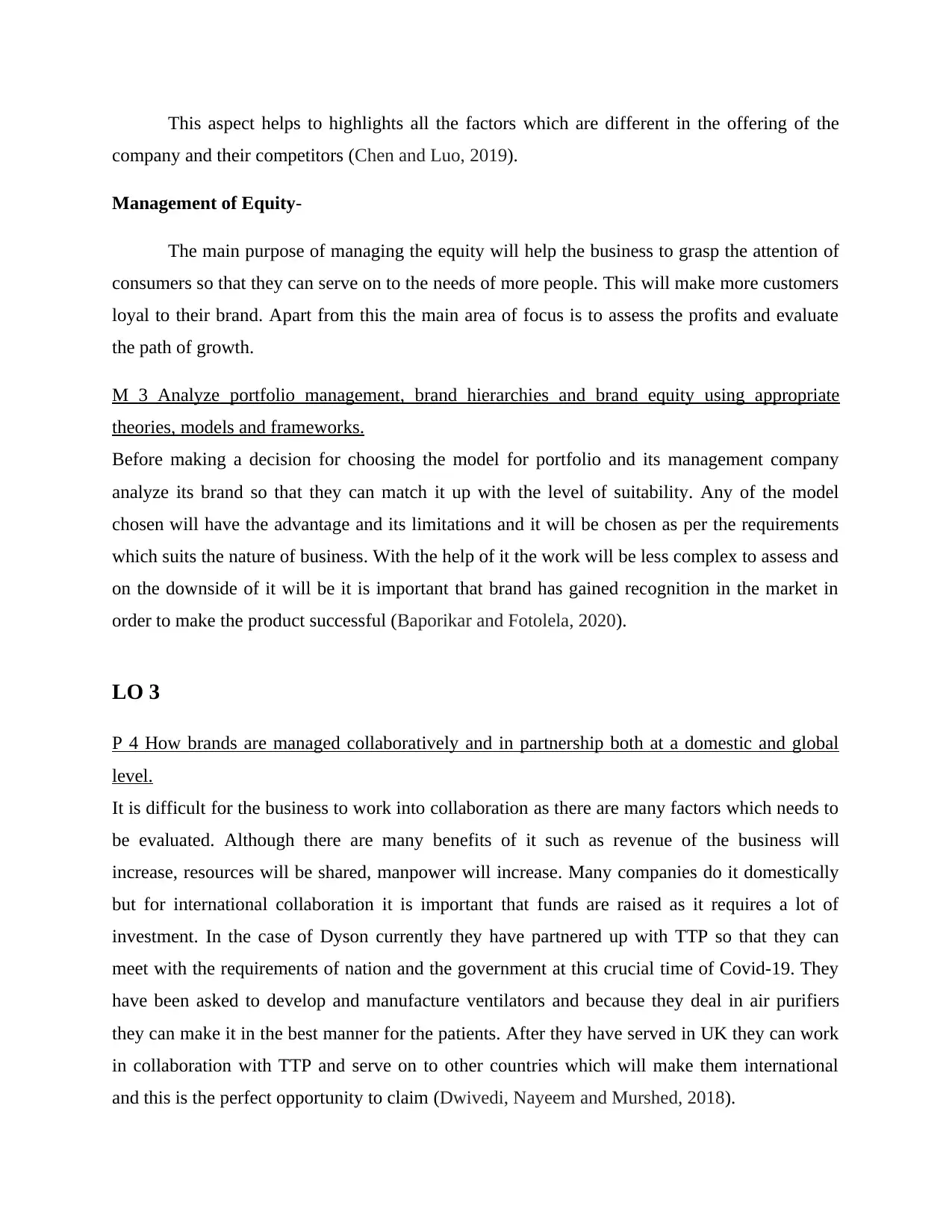
This aspect helps to highlights all the factors which are different in the offering of the
company and their competitors (Chen and Luo, 2019).
Management of Equity-
The main purpose of managing the equity will help the business to grasp the attention of
consumers so that they can serve on to the needs of more people. This will make more customers
loyal to their brand. Apart from this the main area of focus is to assess the profits and evaluate
the path of growth.
M 3 Analyze portfolio management, brand hierarchies and brand equity using appropriate
theories, models and frameworks.
Before making a decision for choosing the model for portfolio and its management company
analyze its brand so that they can match it up with the level of suitability. Any of the model
chosen will have the advantage and its limitations and it will be chosen as per the requirements
which suits the nature of business. With the help of it the work will be less complex to assess and
on the downside of it will be it is important that brand has gained recognition in the market in
order to make the product successful (Baporikar and Fotolela, 2020).
LO 3
P 4 How brands are managed collaboratively and in partnership both at a domestic and global
level.
It is difficult for the business to work into collaboration as there are many factors which needs to
be evaluated. Although there are many benefits of it such as revenue of the business will
increase, resources will be shared, manpower will increase. Many companies do it domestically
but for international collaboration it is important that funds are raised as it requires a lot of
investment. In the case of Dyson currently they have partnered up with TTP so that they can
meet with the requirements of nation and the government at this crucial time of Covid-19. They
have been asked to develop and manufacture ventilators and because they deal in air purifiers
they can make it in the best manner for the patients. After they have served in UK they can work
in collaboration with TTP and serve on to other countries which will make them international
and this is the perfect opportunity to claim (Dwivedi, Nayeem and Murshed, 2018).
company and their competitors (Chen and Luo, 2019).
Management of Equity-
The main purpose of managing the equity will help the business to grasp the attention of
consumers so that they can serve on to the needs of more people. This will make more customers
loyal to their brand. Apart from this the main area of focus is to assess the profits and evaluate
the path of growth.
M 3 Analyze portfolio management, brand hierarchies and brand equity using appropriate
theories, models and frameworks.
Before making a decision for choosing the model for portfolio and its management company
analyze its brand so that they can match it up with the level of suitability. Any of the model
chosen will have the advantage and its limitations and it will be chosen as per the requirements
which suits the nature of business. With the help of it the work will be less complex to assess and
on the downside of it will be it is important that brand has gained recognition in the market in
order to make the product successful (Baporikar and Fotolela, 2020).
LO 3
P 4 How brands are managed collaboratively and in partnership both at a domestic and global
level.
It is difficult for the business to work into collaboration as there are many factors which needs to
be evaluated. Although there are many benefits of it such as revenue of the business will
increase, resources will be shared, manpower will increase. Many companies do it domestically
but for international collaboration it is important that funds are raised as it requires a lot of
investment. In the case of Dyson currently they have partnered up with TTP so that they can
meet with the requirements of nation and the government at this crucial time of Covid-19. They
have been asked to develop and manufacture ventilators and because they deal in air purifiers
they can make it in the best manner for the patients. After they have served in UK they can work
in collaboration with TTP and serve on to other countries which will make them international
and this is the perfect opportunity to claim (Dwivedi, Nayeem and Murshed, 2018).
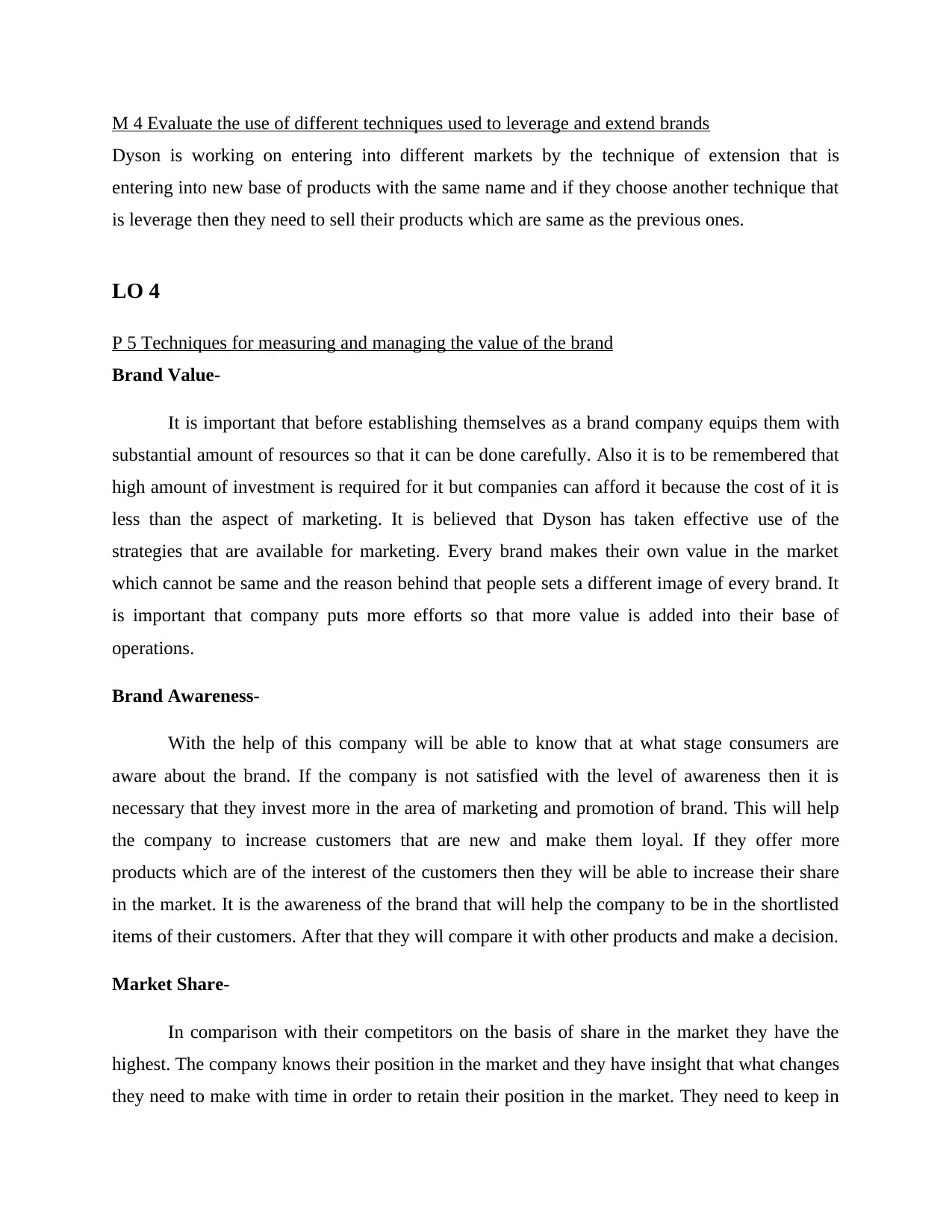
M 4 Evaluate the use of different techniques used to leverage and extend brands
Dyson is working on entering into different markets by the technique of extension that is
entering into new base of products with the same name and if they choose another technique that
is leverage then they need to sell their products which are same as the previous ones.
LO 4
P 5 Techniques for measuring and managing the value of the brand
Brand Value-
It is important that before establishing themselves as a brand company equips them with
substantial amount of resources so that it can be done carefully. Also it is to be remembered that
high amount of investment is required for it but companies can afford it because the cost of it is
less than the aspect of marketing. It is believed that Dyson has taken effective use of the
strategies that are available for marketing. Every brand makes their own value in the market
which cannot be same and the reason behind that people sets a different image of every brand. It
is important that company puts more efforts so that more value is added into their base of
operations.
Brand Awareness-
With the help of this company will be able to know that at what stage consumers are
aware about the brand. If the company is not satisfied with the level of awareness then it is
necessary that they invest more in the area of marketing and promotion of brand. This will help
the company to increase customers that are new and make them loyal. If they offer more
products which are of the interest of the customers then they will be able to increase their share
in the market. It is the awareness of the brand that will help the company to be in the shortlisted
items of their customers. After that they will compare it with other products and make a decision.
Market Share-
In comparison with their competitors on the basis of share in the market they have the
highest. The company knows their position in the market and they have insight that what changes
they need to make with time in order to retain their position in the market. They need to keep in
Dyson is working on entering into different markets by the technique of extension that is
entering into new base of products with the same name and if they choose another technique that
is leverage then they need to sell their products which are same as the previous ones.
LO 4
P 5 Techniques for measuring and managing the value of the brand
Brand Value-
It is important that before establishing themselves as a brand company equips them with
substantial amount of resources so that it can be done carefully. Also it is to be remembered that
high amount of investment is required for it but companies can afford it because the cost of it is
less than the aspect of marketing. It is believed that Dyson has taken effective use of the
strategies that are available for marketing. Every brand makes their own value in the market
which cannot be same and the reason behind that people sets a different image of every brand. It
is important that company puts more efforts so that more value is added into their base of
operations.
Brand Awareness-
With the help of this company will be able to know that at what stage consumers are
aware about the brand. If the company is not satisfied with the level of awareness then it is
necessary that they invest more in the area of marketing and promotion of brand. This will help
the company to increase customers that are new and make them loyal. If they offer more
products which are of the interest of the customers then they will be able to increase their share
in the market. It is the awareness of the brand that will help the company to be in the shortlisted
items of their customers. After that they will compare it with other products and make a decision.
Market Share-
In comparison with their competitors on the basis of share in the market they have the
highest. The company knows their position in the market and they have insight that what changes
they need to make with time in order to retain their position in the market. They need to keep in
Secure Best Marks with AI Grader
Need help grading? Try our AI Grader for instant feedback on your assignments.
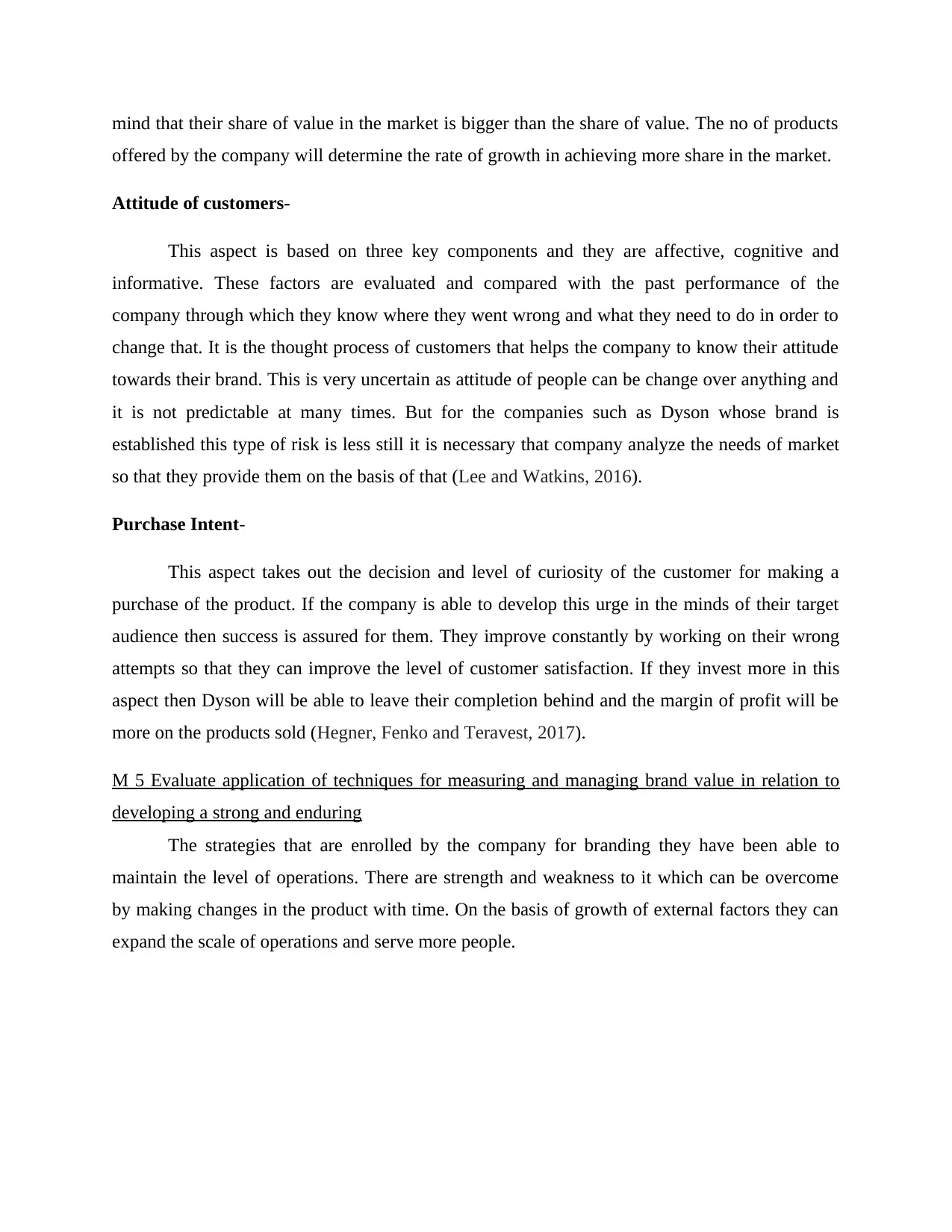
mind that their share of value in the market is bigger than the share of value. The no of products
offered by the company will determine the rate of growth in achieving more share in the market.
Attitude of customers-
This aspect is based on three key components and they are affective, cognitive and
informative. These factors are evaluated and compared with the past performance of the
company through which they know where they went wrong and what they need to do in order to
change that. It is the thought process of customers that helps the company to know their attitude
towards their brand. This is very uncertain as attitude of people can be change over anything and
it is not predictable at many times. But for the companies such as Dyson whose brand is
established this type of risk is less still it is necessary that company analyze the needs of market
so that they provide them on the basis of that (Lee and Watkins, 2016).
Purchase Intent-
This aspect takes out the decision and level of curiosity of the customer for making a
purchase of the product. If the company is able to develop this urge in the minds of their target
audience then success is assured for them. They improve constantly by working on their wrong
attempts so that they can improve the level of customer satisfaction. If they invest more in this
aspect then Dyson will be able to leave their completion behind and the margin of profit will be
more on the products sold (Hegner, Fenko and Teravest, 2017).
M 5 Evaluate application of techniques for measuring and managing brand value in relation to
developing a strong and enduring
The strategies that are enrolled by the company for branding they have been able to
maintain the level of operations. There are strength and weakness to it which can be overcome
by making changes in the product with time. On the basis of growth of external factors they can
expand the scale of operations and serve more people.
offered by the company will determine the rate of growth in achieving more share in the market.
Attitude of customers-
This aspect is based on three key components and they are affective, cognitive and
informative. These factors are evaluated and compared with the past performance of the
company through which they know where they went wrong and what they need to do in order to
change that. It is the thought process of customers that helps the company to know their attitude
towards their brand. This is very uncertain as attitude of people can be change over anything and
it is not predictable at many times. But for the companies such as Dyson whose brand is
established this type of risk is less still it is necessary that company analyze the needs of market
so that they provide them on the basis of that (Lee and Watkins, 2016).
Purchase Intent-
This aspect takes out the decision and level of curiosity of the customer for making a
purchase of the product. If the company is able to develop this urge in the minds of their target
audience then success is assured for them. They improve constantly by working on their wrong
attempts so that they can improve the level of customer satisfaction. If they invest more in this
aspect then Dyson will be able to leave their completion behind and the margin of profit will be
more on the products sold (Hegner, Fenko and Teravest, 2017).
M 5 Evaluate application of techniques for measuring and managing brand value in relation to
developing a strong and enduring
The strategies that are enrolled by the company for branding they have been able to
maintain the level of operations. There are strength and weakness to it which can be overcome
by making changes in the product with time. On the basis of growth of external factors they can
expand the scale of operations and serve more people.
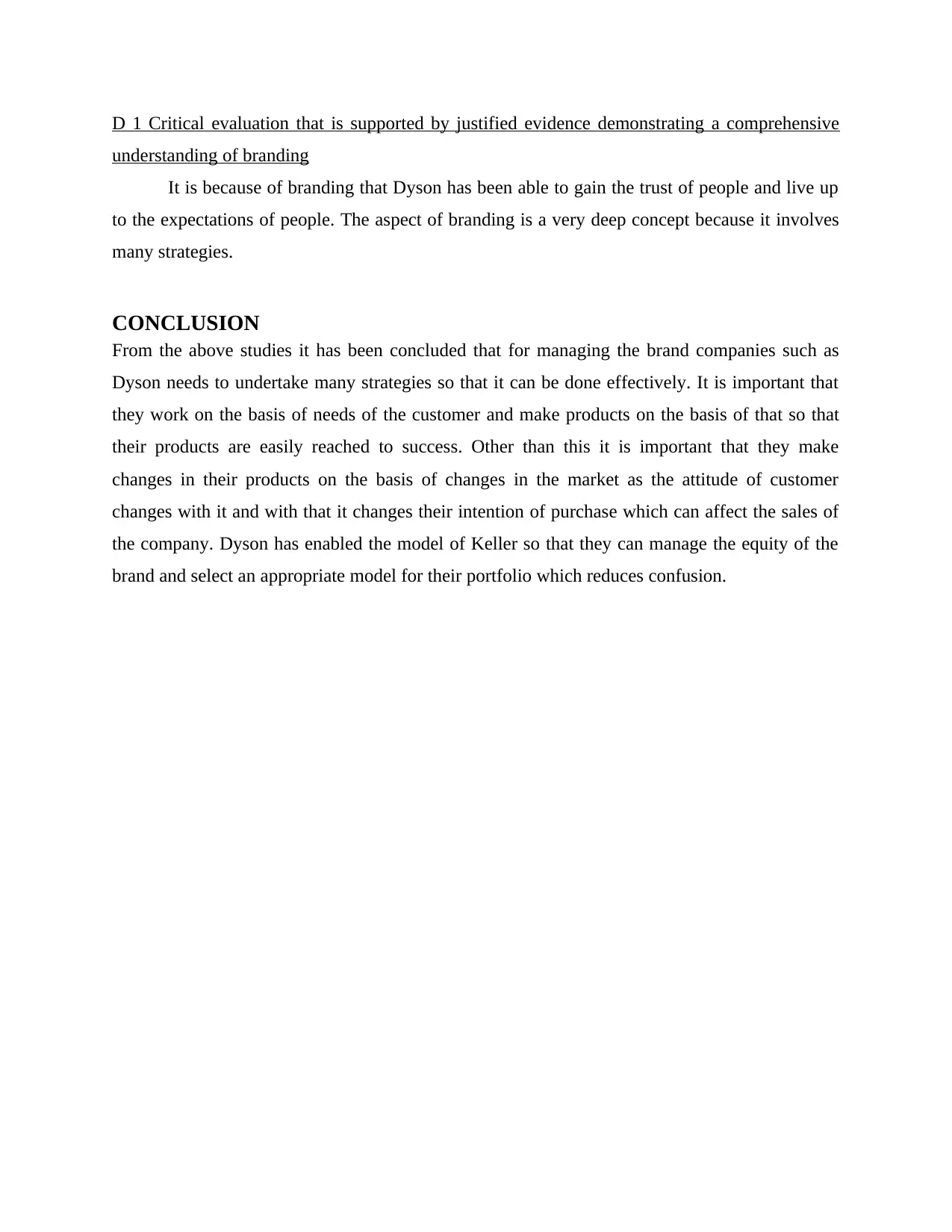
D 1 Critical evaluation that is supported by justified evidence demonstrating a comprehensive
understanding of branding
It is because of branding that Dyson has been able to gain the trust of people and live up
to the expectations of people. The aspect of branding is a very deep concept because it involves
many strategies.
CONCLUSION
From the above studies it has been concluded that for managing the brand companies such as
Dyson needs to undertake many strategies so that it can be done effectively. It is important that
they work on the basis of needs of the customer and make products on the basis of that so that
their products are easily reached to success. Other than this it is important that they make
changes in their products on the basis of changes in the market as the attitude of customer
changes with it and with that it changes their intention of purchase which can affect the sales of
the company. Dyson has enabled the model of Keller so that they can manage the equity of the
brand and select an appropriate model for their portfolio which reduces confusion.
understanding of branding
It is because of branding that Dyson has been able to gain the trust of people and live up
to the expectations of people. The aspect of branding is a very deep concept because it involves
many strategies.
CONCLUSION
From the above studies it has been concluded that for managing the brand companies such as
Dyson needs to undertake many strategies so that it can be done effectively. It is important that
they work on the basis of needs of the customer and make products on the basis of that so that
their products are easily reached to success. Other than this it is important that they make
changes in their products on the basis of changes in the market as the attitude of customer
changes with it and with that it changes their intention of purchase which can affect the sales of
the company. Dyson has enabled the model of Keller so that they can manage the equity of the
brand and select an appropriate model for their portfolio which reduces confusion.

Paraphrase This Document
Need a fresh take? Get an instant paraphrase of this document with our AI Paraphraser
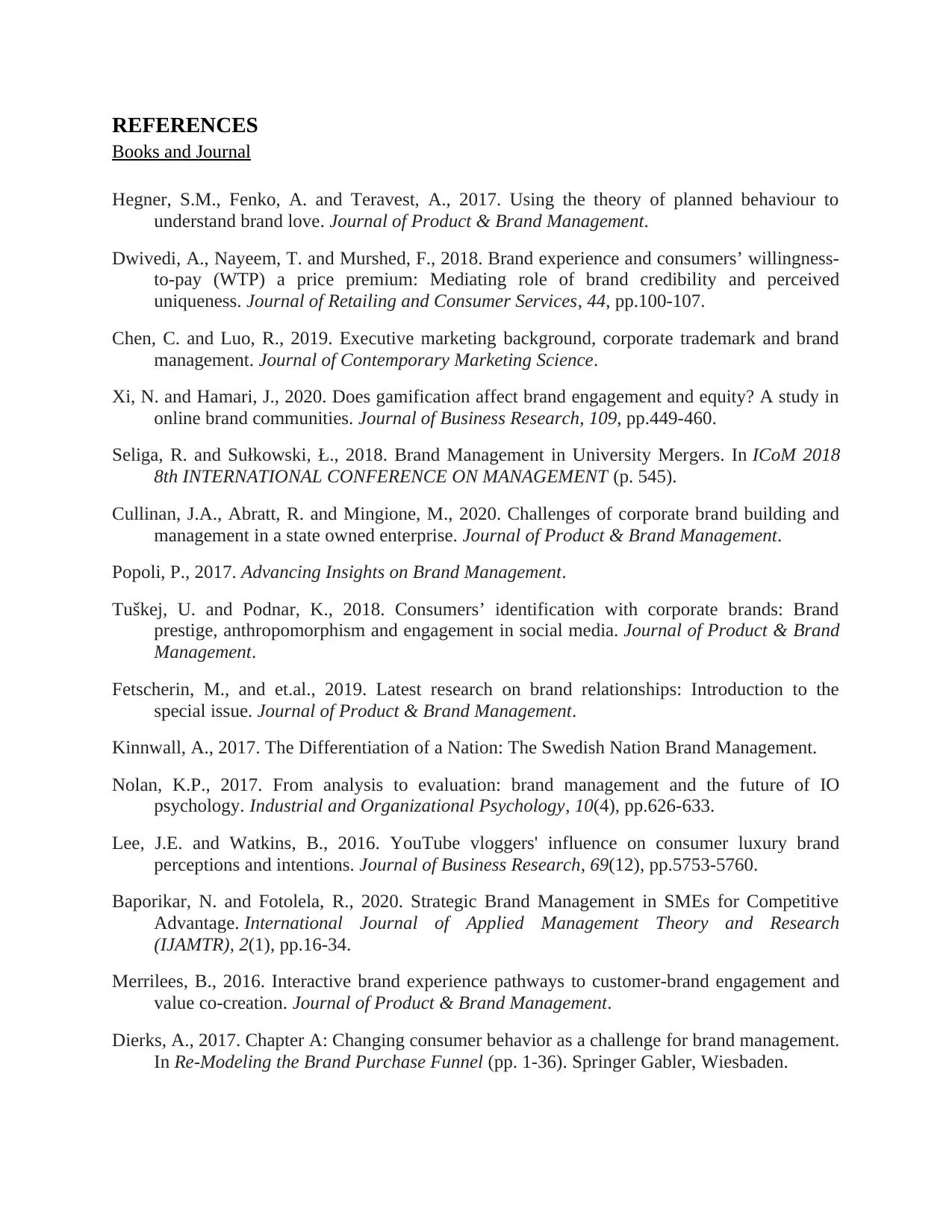
REFERENCES
Books and Journal
Hegner, S.M., Fenko, A. and Teravest, A., 2017. Using the theory of planned behaviour to
understand brand love. Journal of Product & Brand Management.
Dwivedi, A., Nayeem, T. and Murshed, F., 2018. Brand experience and consumers’ willingness-
to-pay (WTP) a price premium: Mediating role of brand credibility and perceived
uniqueness. Journal of Retailing and Consumer Services, 44, pp.100-107.
Chen, C. and Luo, R., 2019. Executive marketing background, corporate trademark and brand
management. Journal of Contemporary Marketing Science.
Xi, N. and Hamari, J., 2020. Does gamification affect brand engagement and equity? A study in
online brand communities. Journal of Business Research, 109, pp.449-460.
Seliga, R. and Sułkowski, Ł., 2018. Brand Management in University Mergers. In ICoM 2018
8th INTERNATIONAL CONFERENCE ON MANAGEMENT (p. 545).
Cullinan, J.A., Abratt, R. and Mingione, M., 2020. Challenges of corporate brand building and
management in a state owned enterprise. Journal of Product & Brand Management.
Popoli, P., 2017. Advancing Insights on Brand Management.
Tuškej, U. and Podnar, K., 2018. Consumers’ identification with corporate brands: Brand
prestige, anthropomorphism and engagement in social media. Journal of Product & Brand
Management.
Fetscherin, M., and et.al., 2019. Latest research on brand relationships: Introduction to the
special issue. Journal of Product & Brand Management.
Kinnwall, A., 2017. The Differentiation of a Nation: The Swedish Nation Brand Management.
Nolan, K.P., 2017. From analysis to evaluation: brand management and the future of IO
psychology. Industrial and Organizational Psychology, 10(4), pp.626-633.
Lee, J.E. and Watkins, B., 2016. YouTube vloggers' influence on consumer luxury brand
perceptions and intentions. Journal of Business Research, 69(12), pp.5753-5760.
Baporikar, N. and Fotolela, R., 2020. Strategic Brand Management in SMEs for Competitive
Advantage. International Journal of Applied Management Theory and Research
(IJAMTR), 2(1), pp.16-34.
Merrilees, B., 2016. Interactive brand experience pathways to customer-brand engagement and
value co-creation. Journal of Product & Brand Management.
Dierks, A., 2017. Chapter A: Changing consumer behavior as a challenge for brand management.
In Re-Modeling the Brand Purchase Funnel (pp. 1-36). Springer Gabler, Wiesbaden.
Books and Journal
Hegner, S.M., Fenko, A. and Teravest, A., 2017. Using the theory of planned behaviour to
understand brand love. Journal of Product & Brand Management.
Dwivedi, A., Nayeem, T. and Murshed, F., 2018. Brand experience and consumers’ willingness-
to-pay (WTP) a price premium: Mediating role of brand credibility and perceived
uniqueness. Journal of Retailing and Consumer Services, 44, pp.100-107.
Chen, C. and Luo, R., 2019. Executive marketing background, corporate trademark and brand
management. Journal of Contemporary Marketing Science.
Xi, N. and Hamari, J., 2020. Does gamification affect brand engagement and equity? A study in
online brand communities. Journal of Business Research, 109, pp.449-460.
Seliga, R. and Sułkowski, Ł., 2018. Brand Management in University Mergers. In ICoM 2018
8th INTERNATIONAL CONFERENCE ON MANAGEMENT (p. 545).
Cullinan, J.A., Abratt, R. and Mingione, M., 2020. Challenges of corporate brand building and
management in a state owned enterprise. Journal of Product & Brand Management.
Popoli, P., 2017. Advancing Insights on Brand Management.
Tuškej, U. and Podnar, K., 2018. Consumers’ identification with corporate brands: Brand
prestige, anthropomorphism and engagement in social media. Journal of Product & Brand
Management.
Fetscherin, M., and et.al., 2019. Latest research on brand relationships: Introduction to the
special issue. Journal of Product & Brand Management.
Kinnwall, A., 2017. The Differentiation of a Nation: The Swedish Nation Brand Management.
Nolan, K.P., 2017. From analysis to evaluation: brand management and the future of IO
psychology. Industrial and Organizational Psychology, 10(4), pp.626-633.
Lee, J.E. and Watkins, B., 2016. YouTube vloggers' influence on consumer luxury brand
perceptions and intentions. Journal of Business Research, 69(12), pp.5753-5760.
Baporikar, N. and Fotolela, R., 2020. Strategic Brand Management in SMEs for Competitive
Advantage. International Journal of Applied Management Theory and Research
(IJAMTR), 2(1), pp.16-34.
Merrilees, B., 2016. Interactive brand experience pathways to customer-brand engagement and
value co-creation. Journal of Product & Brand Management.
Dierks, A., 2017. Chapter A: Changing consumer behavior as a challenge for brand management.
In Re-Modeling the Brand Purchase Funnel (pp. 1-36). Springer Gabler, Wiesbaden.

Shtovba, S., Shtovba, O. and Filatova, L., 2019. The current state of brand management
research. The Bottom Line.
research. The Bottom Line.
1 out of 15
Related Documents
Your All-in-One AI-Powered Toolkit for Academic Success.
+13062052269
info@desklib.com
Available 24*7 on WhatsApp / Email
![[object Object]](/_next/static/media/star-bottom.7253800d.svg)
Unlock your academic potential
© 2024 | Zucol Services PVT LTD | All rights reserved.





